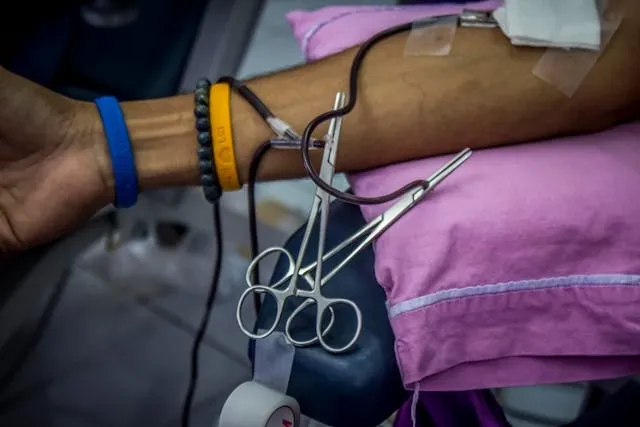Yellow Wristband Hospital: Meaning, Codes, And Safety Implications
Hospitals use wristband systems to quickly identify patient needs, reduce risks, and ensure proper care. Among these the yellow wristband hospital system plays a key role in patient safety. A yellow hospital wristband usually signals that a patient has a high risk of falling, prompting extra attention from healthcare staff.
In this guide, we explain what a yellow wristband at hospital means and also explore how it connects to other color-coded bands. Read on to explore safety implications and why these identifiers are central to modern healthcare systems.

Key Takeaways
- A yellow wristband in hospital typically means the patient is at risk of falling, but there may be additional notes for more specific details.
- Color-coded wristbands, including yellow hospital bracelet identifiers, standardize safety communication and families and caregivers should be aware of meanings.
- Staff use the yellow risk band in hospital to prompt extra safety measures - always confirm with medical professionals if unsure about a hospital band.
- For hospital operators, we supply high-quality custom wristbands in silicone, fabric, and other varieties for your to meet your color-coding needs.
Table of contents
Yellow Wristband Hospital
In healthcare settings, the yellow wristband hospital system is a simple visible indicator for patient safety. Specifically, a yellow wristband in hospital settings means that the patient has a heightened risk of falling.
Common health factors that contribute to this risk include:
- Age
- Medication side effects
- Mobility challenges
Statistics show that, each year, there are nearly 1 million patient falls in hospitals, leading to over 250,000 injuries.
When staff see a yellow hospital wristband, or perhaps a yellow round button on a patient, they know that the wearer requires additional support. This could include assisting the patient when walking or making adjustments to their environment for safety. The yellow wristband meaning in hospitals is standardized throughout the U.S. to streamline communication across departments - just like why we make badge reels for medical professional ID cards.
It’s important to note that hospital protocols can differ, so it is recommended that you confirm with staff about the yellow wristband meaning. Families might also notice caregivers taking extra precautions with patients wearing a yellow wristband. Ultimately, these identifiers are a crucial component of fall-prevention programs, reducing injury rates and improving care.

What Does A Yellow Band On The Wrist Mean Outside The Hospital?
Outside of healthcare environments, a yellow wristband may carry completely different symbolic meanings. A yellow wristband in a hospital setting indicates a fall risk but, in public life, it could represent awareness or support campaigns.
For example, we have seen yellow bands associated with things like:
- Cancer awareness
- Suicide prevention
- Humanitarian efforts
Some people simply wear them as fashion items, not realizing that they have strong medical associations. It is important not to confuse a wristband worn for charity or style with the yellow wristband meaning in a hospital. If you spot someone wearing a yellow band outside clinical settings, it probably has no medical relevance.
Always treat a yellow wristband at hospital as a medical safety alert, but recognize that outside contexts may be symbolic or personal. If you are looking to create your own identifier, merchandise, or fashion accessory, work with us to create custom debossed colorfilled wristbands and other varieties for events, causes, or anything else.
Looking for blank, color-coded silicone wristbands?
With our service, you can bulk order custom blank wristbands for a simple, durable solution for your hospital.
What Do Different Color Wristbands Mean At A Hospital?
Beyond the yellow wristband in hospitals, facilities often use multiple colors to indicate distinct patient conditions. As experts in creating such products, we can confirm that unclear designs are among the most common mistakes when using promotional products like wristbands.
Color coding ensures that staff can recognize essential information at a glance. Let’s look at some examples:
- Yellow hospital wristbands: These communicate a heightened fall risk for the wearer.
- Red wristbands: Patients wear these to indicate allergies.
- Purple wristbands: This may signify a Do Not Resuscitate (DNR) order.
- Other shades: Green and other hues can relate to special precautions.
The purpose of these codes is to standardize communication and reduce misunderstandings that could compromise patient safety. Still, not every hospital follows the same color-coding, so the yellow wrist band in hospital could have slight variations. It’s part of a broader safety protocol that includes education for staff and awareness for patient families.
Color-coded wristbands are some of the most commonly-used identifiers across U.S. facilities, supported by recommendations from national hospital associations. When used consistently, these systems help streamline responses and improve outcomes.
|
Color |
Meaning (Common Standard) |
Notes / Variations |
|
Yellow |
Fall risk |
Alerts staff that the patient may require extra assistance with mobility. |
|
Red |
Allergies |
Indicates the patient has allergies (often to medications, foods, or materials). |
|
Purple |
Do Not Resuscitate (DNR) |
Signals that CPR or other resuscitation should not be performed. |
|
Pink |
Restricted limb |
Used when a limb should not be used for IVs, blood draws, or blood pressure cuffs. |
|
Green |
Special precautions |
May signal latex allergy, infection control, or other hospital-specific protocols. |
|
Blue |
Vulnerable patient |
Sometimes used for patients with dementia, developmental delays, or cognitive impairments (not universal). |
|
White / Clear |
Standard ID |
Basic identification wristband, usually with patient details and barcode. |
What Are The Color-Coded Wristbands For Patients?
The yellow wristband at hospital is just one example of a wider system of color-coded identifiers that simplify communication for staff. Different colors are designed to alert medical teams without requiring lengthy chart reviews.
Common wristband colors include:
- Red (allergies)
- Yellow (fall risk)
- Purple (DNR)
- Pink (Restricted limb)
- Green (Special precautions)
If a patient wears the yellow hospital band, nurses and aides know to exercise extra caution when helping them move, reducing the risk of falls. The American Hospital Association has provided guidelines that encourage consistency, and studies have shown that color-coding can quickly classify patient information and initiate treatment protocols.
Certain hospitals may include additional printed notes along with the wristband to clarify the risk involved. For patients, families, and caregivers, these identifiers simplify understanding and cooperation. Colored wristbands for patients ultimately work in harmony with hospital protocols to avoid confusion, standardize safety practices, and make medical care more efficient.
When A Person Has A Yellow Wristband, What Should You Do?
If you notice a patient wearing a yellow wristband in hospital, the most important step is to be cautious. A yellow wrist band in hospital alerts staff and visitors that the patient may have balance issues or be prone to falls.
As a caregiver or visitor, you should avoid encouraging the wearer to move independently without professional help. Instead, notify staff before assisting with anything like:
- Walking
- Transferring
- Repositioning
A hospital yellow wristband is a safety reminder, not a warning of illness or infection. By paying attention to it, you are helping prevent accidents. Even something as simple as moving a chair or adjusting bedding should be done with care and respect for the patient’s mobility limitations.
Paying attention to wristband meanings in hospital ensures that everyone - from family members to nurses - understands the type of care and attention a patient requires. Whether they wear a silicone or a custom safety breakaway polyester wristband, you need to show patience, awareness, and collaboration with staff.

Why Should You Beware Of Yellow Wristbands At The Hospital?
The phrase “beware” in relation to the yellow wristband hospital system is not about danger - it refers to awareness. A hospital patient who wears a yellow wristband or nylon lanyard is at risk of falling, so extra caution is needed from:
- Staff
- Caregivers
- Visitors
This isn’t a warning about infection or severe illness, but you shouldn’t ignore the yellow wristband as it could result in preventable accidents. Patients who have limited mobility, balance issues, or medication side effects are often assigned a yellow wrist and in hospital so their vulnerabilities are clear at a glance. This helps avoid miscommunication during busy shifts.
Families should also understand that the yellow wristband reflects a protective measure, encouraging safe interactions and appropriate assistance. Hospitals are advised that there are many benefits of using eco-friendly promotional products like wristbands, so explore fabric bands or reusable silicone options.
This system is not about fear - it’s about proactive safety. Viewing a yellow bracelet hospital correctly ensures patients remain as safe and supported as possible.
Create custom printed wristbands for a more sophisticated option
We supply high-quality custom printed wristbands made from silicone to add high-definition details to your colored bands.
Learn moreWhat Color Is The DNR Band In A Hospital?
In contrast to the yellow wristband in hospital, which signifies fall risk, a DNR (Do Not Resuscitate) band communicates a very different medical instruction. Typically, the DNR wristband is purple, though there might be some variation between facilities.
We have talked about a wristband color that is about mobility safety, but the purple DNR band signals a legal and ethical directive regarding life-saving measures. When staff see a purple wristband, they know that resuscitation efforts like CPR should not be initiated if the patient’s heart or breathing stops. Studies show that DNR orders are usually issued due to a desire to avoid suffering or aggressive end-of-life care.
The purple wristband differs fundamentally from the yellow hospital wristband, which simply calls for fall-prevention efforts. Families need to understand that the DNR decision is made in consultation with physicians and loved ones - it is never made arbitrarily. A purple DNR band is all about end-of-life preferences.
The color-coding system reflects the importance of visible communication tools that prevent misunderstandings and respect the rights of patients.
What Color Is The Vulnerable Patient Band?
The yellow wristband in hospital denotes fall risk, but vulnerable patients are often given a different identifier in hospital. A “vulnerable patient” is usually defined as someone with impairments that make it difficult to care for themselves, such as:
- Dementia
- Developmental delays
- Conditions that affect decision-making
Wristbands for this purpose are often blue, though colors may vary at different institutions. Just like we make badge holders for hospital staff, we make wristbands that can be used for patient identifiers. The yellow is focused on fall prevention, but the vulnerable patient band is all about alerting staff that the individual may need extra monitoring, communication adjustments, or protective measures.
There may be cases where a facility used a yellow wrist band at hospital to signify vulnerability, but this is not the norm. Identifying vulnerable patients ensures staff can provide care with the necessary patience and safety oversight. Some wristbands relate to physical stability, but this band reflects broader needs.
Whether it’s a fall risk, cognitive impairment, or emotional support, color-coded identifiers play a critical role in tailoring healthcare services effectively.
Why Does A Yellow Hospital Bracelet Mean Fall Risk?
The yellow hospital bracelet has become a universal symbol for fall risk, largely due to recommendations from organizations like the American Hospital Association. Assigning a yellow wristband hospital to at-risk patients helps reduce injury rates by instantly alerting staff to the wearer’s condition.
A fall-risk assessment is usually conducted upon admission. It considers things like:
- Age
- Medications
- Mobility
- Medical history
If deemed necessary, the patient will be issued with a yellow vinyl wristband to cue staff to provide mobility aids, assist with transfers, and take other precautions. Unlike other identifiers, like red for allergies or purple for DNR, the yellow wristband at hospital serves as a proactive safety tool.
A 2013 study demonstrated that red wristbands significantly improved emergency management and staff awareness in a hospital, so these color-coded bands really work. This system is not punitive but protective, ensuring that patients receive the right level of support.
This simple system saves lives and reduces complications during hospital stays.

Legal And Ethical Consequences Of Wristband Misuse
Ignoring or misapplying hospital wristband color codes can lead to serious harm. Patients may receive the wrong treatment, leading to things like:
- Injury
- Liability claims
- Compliance violations
Ethically, misuse undermines the trust between families and healthcare providers. Use wristbands correctly for both safety and responsible professionalism in healthcare settings.
Looking for an alternative to silicone wristbands?
Work with us to create custom full-color polyester wristbands for a stylish and comfortable alternative to silicone.
Frequently Asked Questions About Yellow Wristband Hospital
What Does Yellow Wristband Hospital Mean For Patients?
A yellow wristband in hospital means the patient is considered at high risk of falling. Staff will provide added support when that patient moves, and visitors should be cautious. The hospital yellow wristband is a preventative safety measure, not an indicator of illness.
What Do Different Color Bands Mean At A Hospital?
Color-coded wristbands can vary by facility, but they generally include red (allergens), yellow (fall risk), purple (DNR), pink (restricted limb), and green (special precautions). The yellow wristband hospital is among the most common, acting as a universal fall-risk signal.